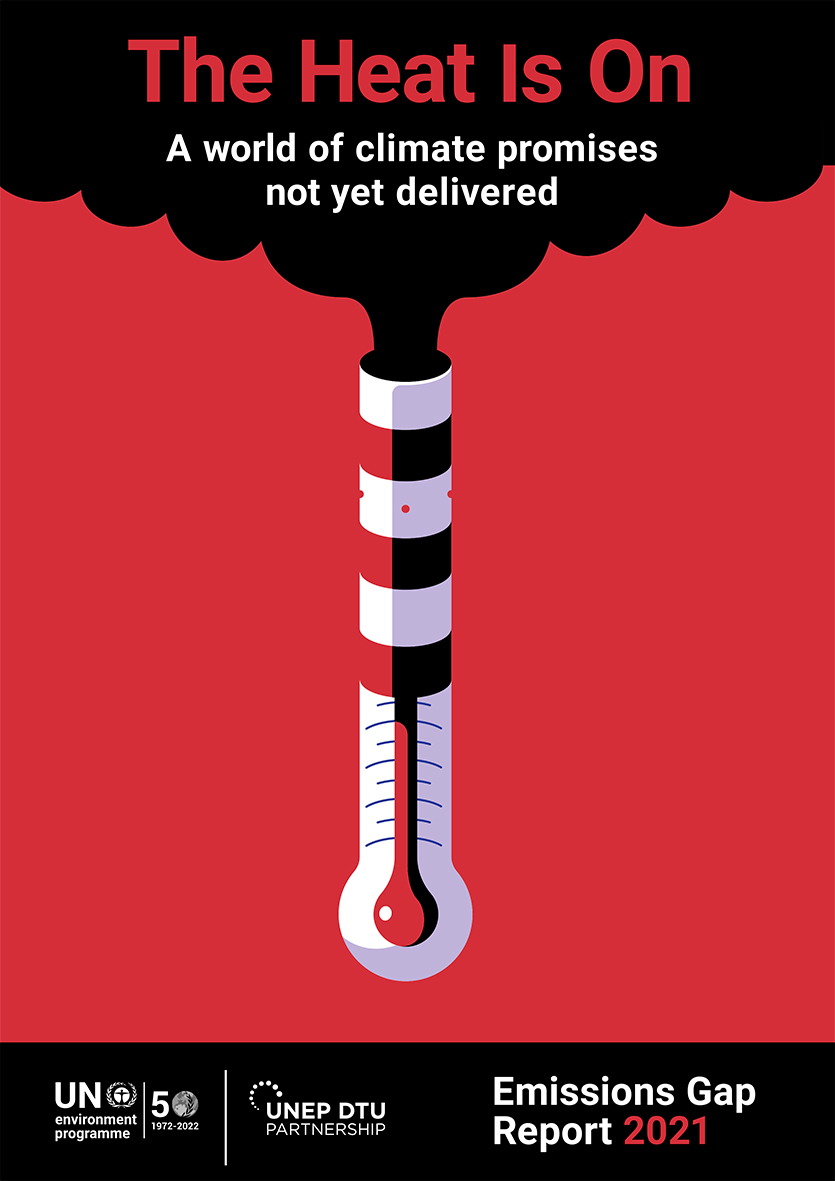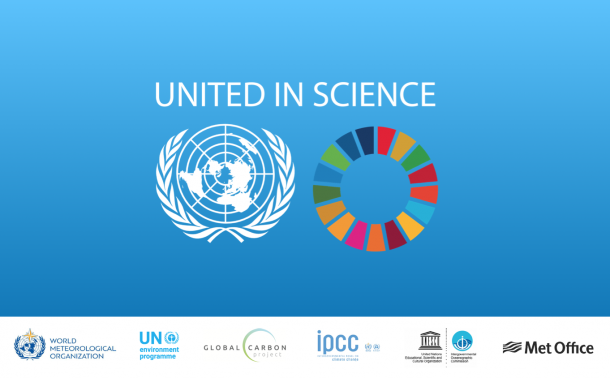New and updated climate commitments fall far short of what is needed to meet the goals of the Paris Agreement, leaving the world on track for a global temperature rise of at least 2.7°C this century, according to the latest UNEP Emissions Gap Report 2021: The Heat Is On.
The Emissions Gap Report is coordinated by UNEP DTU Partnership, and Head of Strategy for Climate Planning and Policy, Anne Olhoff, along with several other UNEP DTU Partnership experts, are among the report’s main authors.
“Countries’ new climate plans and targets for 2030 show some progress, but they are far from sufficient to bridge the emissions gap. The ambition implied by the new 2030 pledges would need to be 4 times higher to get on track to 2°C and about 7 times higher to get on track to 1.5°C”, she says of the report’s findings.
The report, now in its 12th year, finds that countries’ updated Nationally Determined Contributions (NDCs) – and other commitments made for 2030 but not yet submitted in an updated NDC – only take an additional 7.5 per cent off predicted annual greenhouse gas emissions in 2030, compared to the previous round of commitments. Reductions of 30 per cent are needed to stay on the least-cost pathway for 2°C and 55 per cent for 1.5°C.
“The clock is ticking loudly”
Released ahead of COP26, the Emissions Gap Report 2021 finds that net-zero pledges could make a big difference. If fully implemented, these pledges could bring the predicted global temperature rise to 2.2°C, providing hope that further action could still head off the most catastrophic impacts of climate change. However, net-zero pledges are still vague, incomplete in many cases, and inconsistent with most 2030 NDCs.
“Climate change is no longer a future problem. It is a now problem,” said Inger Andersen, Executive Director of UNEP. “To stand a chance of limiting global warming to 1.5°C, we have eight years to almost halve greenhouse gas emissions: eight years to make the plans, put in place the policies, implement them and ultimately deliver the cuts. The clock is ticking loudly.”
As of 30 September 2021, 120 countries, representing just over half of global greenhouse gas emissions, had communicated new or updated NDCs. In addition, three G20 members have announced other new mitigation pledges for 2030.
To have any chance of limiting global warming to 1.5°C, the world has eight years to take an additional 28 gigatonnes of CO2 equivalent (GtCO2e) off annual emissions, over and above what is promised in the updated NDCs and other 2030 commitments. To put this number into perspective, carbon dioxide emissions alone are expected to reach 33 gigatonnes in 2021.
When all other greenhouse gases are taken into account, annual emissions are close to 60 GtCO2e. So, to have a chance of reaching the 1.5°C target, we need to almost halve greenhouse gas emissions. For the 2°C target, the additional need is lower: a drop in annual emissions of 13 GtCO2e by 2030.
Zeroing in on net-zero
Net-zero pledges – and their effective execution – could make a big difference, the authors find, but current plans are vague and not reflected in NDCs. A total of 49 countries plus the EU have pledged a net-zero target. This covers over half of GDP and a third of the global population. Eleven targets are enshrined in law, covering 12 per cent of global emissions.
“It is very promising that an increasing number of countries are pledging net-zero emissions by around mid-century. By now, more than 50% of global GHG emissions are covered by such pledges. But these pledges are in many cases not reflected in in near-term plans and action. That has to urgently change to maintain confidence that the net-zero emissions pledges can actually be achieved” Anne Olhoff says.
If made robust and implemented fully, net-zero targets could shave an extra 0.5°C off global warming, bringing the predicted temperature rise down to 2.2°C. However, many of the national climate plans delay action until after 2030, raising doubts over whether net-zero pledges can be delivered. Twelve G20 members have pledged a net-zero target, but they are still highly ambiguous. Action also needs to be frontloaded to make it in line with 2030 goals.
“The world has to wake up to the imminent peril we face as a species,” Andersen added. “Nations need to put in place the policies to meet their new commitments, and start implementing them within months. They need to make their net-zero pledges more concrete, ensuring these commitments are included in NDCs, and action brought forward. They then need to get the policies in place to back this raised ambition and, again, start implementing them urgently.
“It is also essential to deliver financial and technological support to developing nations – so that they can both adapt to the impacts of climate change already here and set out on a low-emissions growth path.”
The potential of methane and market mechanisms
Every year, the Emissions Gap Report looks at the potential of specific sectors. This year, it focuses on methane and market mechanisms. Reduction of methane emissions from the fossil fuel, waste and agriculture sectors can contribute to closing the emissions gap and reduce warming in the short term.
Methane emissions are the second largest contributor to global warming. The gas has a global warming potential over 80 times that of carbon dioxide over a 20-year horizon; it also has a shorter lifetime in the atmosphere than carbon dioxide – only twelve years, compared to up to hundreds for CO2 – so cuts to methane will limit temperature increase faster than cuts to carbon dioxide.
Available no- or low-cost technical measures alone could reduce anthropogenic methane emissions by around 20 per cent per year. Implementation of all measures, along with broader structural and behavioural measures, could reduce anthropogenic methane emissions by approximately 45 per cent.
Carbon markets, meanwhile, have the potential to reduce costs and thereby encourage more ambitious reduction pledges, but only if rules are clearly defined, are designed to ensure that transactions reflect actual reductions in emissions, and are supported by arrangements to track progress and provide transparency.
Revenues earned through these markets could fund mitigation and adaptation solutions domestically and in vulnerable nations where the burdens of climate change are greatest.
COVID-19 recovery opportunity largely missed
Finally, the report finds that the opportunity to use COVID-19 fiscal rescue and recovery spending to stimulate the economy while backing climate action has been missed in most countries.
The COVID-19 pandemic led to a drop in global CO2 emissions of 5.4 per cent in 2020. However, CO2 and non-CO2 emissions in 2021 are expected to rise again to a level only slightly lower than the record high in 2019.
Only around 20 per cent of total recovery investments up to May 2021 are likely to reduce greenhouse gas emissions. Of this spending, almost 90 per cent is accounted for by six G20 members and one permanent guest.
COVID-19 spending has been far lower in low-income economies (USD 60 per person) than advanced economies (USD 11,800 per person). Gaps in finance are likely to exacerbate gaps in vulnerable nations on climate resilience and mitigation measures.
COP26 update
A preliminary assessment of the impact of new or updated nationally determined contributions, other 2030 pledges and net-zero emissions pledges announced or submitted since the cut-off dates of the Emissions Gap Report 2021.




